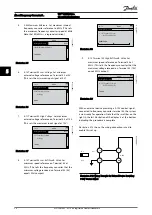
2.4.5.9 Mechanical Brake Control
In hoisting/lowering applications, it is necessary to be able
to control an electro-mechanical brake:
•
Control the brake using any relay output or
digital output (terminal 27 or 29).
•
Keep the output closed (voltage-free) as long as
the frequency converter is unable to ‘support’ the
motor, for example due to the load being too
heavy.
•
Select
Mechanical brake control
[32] in par. 5-4*
for applications with an electro-mechanical brake.
•
The brake is released when the motor current
exceeds the preset value in
2-20 Release Brake
Current
.
•
The brake is engaged when the output frequency
is less than the frequency set in
2-21 Activate
Brake Speed [RPM]
or
2-22 Activate Brake Speed
[Hz]
, and only if the frequency converter carries
out a stop command.
If the frequency converter is in alarm mode or in an over-
voltage situation, the mechanical brake immediately cuts
in.
In the vertical movement, the key point is that the load
must be held, stopped, controlled (raised, lowered) in a
perfectly safe mode during the entire operation. Because
the frequency converter is not a safety device, the crane/
lift designer (OEM) must decide on the type and number
of safety devices (e.g. speed switch, emergency brakes etc.)
to be used, in order to be able to stop the load in case of
emergency or malfunction of the system, according to
relevant national crane/lift regulations.
L1
L2
L3
U
V
W
02
01
A1
A2
130BA902.10
Drive
Output
relay
Command Circuit
220Vac
Mechanical
Brake
Shaft
Motor
Frewheeling
diode
Brake
380Vac
Output
Contactor
Input
Power Circuit
Illustration 2.24 Connecting the Mechanical Brake to the
frequency converter
2.4.6 Serial Communication
Connect RS-485 serial communication wiring to terminals
(+)68 and (-)69.
•
Screened serial communication cable is
recommended
•
See
2.4.2 Earth (Grounding) Requirements
for
proper grounding
61
68
69
+
130BB489.10
RS-485
Illustration 2.25 Serial Communication Wiring Diagram
For basic serial communication set up, select the following
1.
Protocol type in
8-30 Protocol
.
2.
Frequency converter address in
8-31 Address
.
3.
Baud rate in
8-32 Baud Rate
.
•
Four communication protocols are internal to the
frequency converter. Follow motor manufacturer
wiring requirements.
Danfoss FC
Modbus RTU
Johnson Controls N2
®
•
Functions can be programmed remotely using
the protocol software and RS-485 connection or
in parameter group 8-**
Communications and
Options
•
Selecting a specific communication protocol
changes various default parameter settings to
match that protocol’s specifications along with
making additional protocol-specific parameters
available
•
Option cards which install into the frequency
converter are available to provide additional
communication protocols. See the option-card
documentation for installation and operation
instructions
Installation
VLT
®
AQUA Drive
Operating Instructions
22
MG.20.M8.02 - VLT
®
is a registered Danfoss trademark
2
2
















































